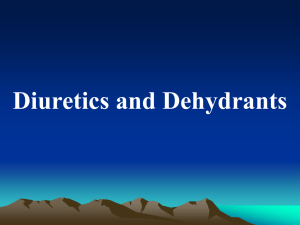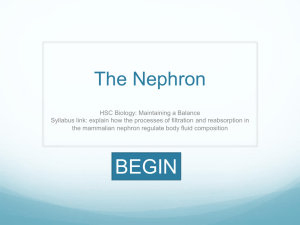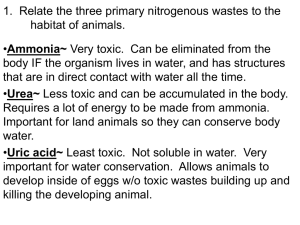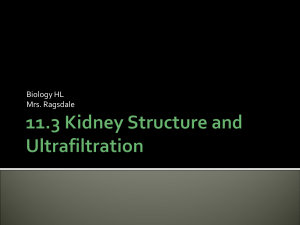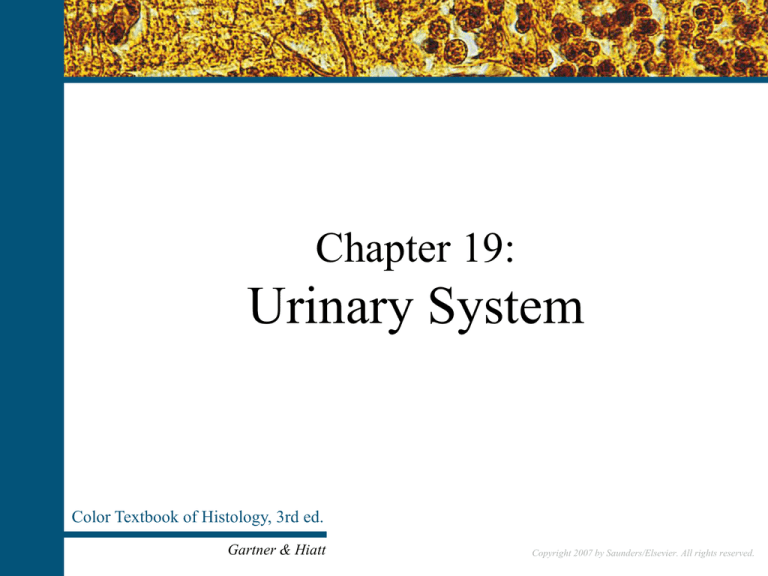
Chapter 19:
Urinary System
Color Textbook of Histology, 3rd ed.
Gartner & Hiatt
Copyright 2007 by Saunders/Elsevier. All rights reserved.
Copyright 2007 by Saunders/Elsevier. All rights reserved.
Hemisected Kidney
Each kidney has a cortex and a medulla. The cortex presents
(1) renal corpuscles; (2) cortical labyrinth; and (3)
longitudinal striations, medullary rays, whereas the medulla
contains the renal pyramids, whose bases form the
corticomedullary border. The apex of a renal pyramid, the
renal papilla, is perforated by 20 or so openings of the ducts
of Bellini. The apex is surrounded by a cup-like minor calyx,
two or three of which drain into a major calyx. These, in
turn, empty into the renal pelvis.
Neighboring pyramids are separated from each other by
material resembling the cortex, the cortical columns (of
Bertin).
A renal pyramid, with its associated cortical arch and cortical
columns, represents a lobe of the kidney. Each medullary ray
with part of the cortical labyrinth surrounding it is considered
a kidney lobule, which continues into the medulla as a coneshaped structure.
The functional unit of the kidney is the uriniferous tubule, a
highly convoluted structure that modifies the fluid passing
through it to form urine as its final output. Uriniferous
tubules are densely packed so that the connective tissue
stroma of the kidney is scant. The entire uriniferous tubule is
epithelial in nature and is, therefore, separated from the
connective tissue stroma by an intervening basal lamina.
This tubule consists of two parts, each with a different
embryological origin, the nephron and the collecting tubule.
There are approximately 1.3 million nephrons in each kidney.
Several nephrons are drained by a single collecting tubule.
Figure 19–1 A, Hemisected kidney illustrating morphology and circulation. B, Arrangement of
cortical and juxtamedullary nephrons.
Copyright 2007 by Saunders/Elsevier. All rights reserved.
For more information see Overview of Kidney section in Chapter 19 of
Gartner and Hiatt: Color Textbook of Histology, 3rd ed. Philadelphia,
W.B. Saunders, 2007.
Nephron
Two types of nephrons are found in the human kidney: shorter
cortical nephrons and longer juxtamedullary nephrons,
whose renal corpuscle is located in the cortex and whose tubular
parts are located in the medulla. The specific locations of the
two types of nephrons, the cellular composition of their various
regions, and the specific alignments of these regions in register
with one another permit the subdivision of the medulla into an
outer zone and an inner zone. The outer zone of the medulla is
further subdivided into an outer stripe and an inner stripe.
Unless otherwise noted, all of the descriptions in this textbook
refer to juxtamedullary nephrons, even though they constitute
only 15% of all nephrons.
Each juxtamedullary nephron is about 40 mm long. The
constituent parts of the nephron are modified to perform specific
physiological functions. The renal corpuscle, with its attendant
glomerulus, filters the fluid expressed from the bloodstream. The
subsequent tubular portions of the nephron (i.e., the proximal
tubule, the thin limbs of Henle’s loop, and the distal tubule)
modify the filtrate to form urine.
For more information see the Nephron section in Chapter 19 of Gartner and
Hiatt: Color Textbook of Histology, 3rd ed. Philadelphia, W.B. Saunders,
2007.
Figure 19–2 Light micrograph of the kidney cortex in a monkey, illustrating renal
corpuscles (R), medullary ray (M), and cross-sectional profiles of the uriniferous tubules
(´132). A portion of the urinary space (S) is clearly evident at the periphery of the renal
corpuscle and is bound by the simple squamous epithelium composing the parietal layer
(P) of Bowman’s capsule.
Copyright 2007 by Saunders/Elsevier. All rights reserved.
Renal Corpuscle
Figure 19–4 A renal corpuscle and its juxtaglomerular apparatus.
The renal corpuscle is composed of a tuft of capillaries, the glomerulus, which is invaginated into Bowman’s capsule, the dilated, pouch-like, proximal end of the
nephron.
The glomerulus contacts the visceral layer of Bowman’s capsule, composed of modified epithelial cells called podocytes. The outer wall surrounding Bowman’s
space, is the parietal layer.
The glomerulus is supplied by the short, straight afferent glomerular arteriole and drained by the efferent glomerular arteriole.
Filtrate leaking out of the glomerulus enters Bowman’s space through a complex filtration barrier composed of the endothelial wall of the capillary, the basal
lamina, and the visceral layer of Bowman’s capsule.
The glomerulus is formed as several tufts of anastomosing capillaries that arise from branches of the afferent glomerular arteriole. The connective tissue component
does not enter Bowman’s capsule, and is replaced by a specialized cell type known as mesangial cells. There are two groups of mesangial cells: Extraglomerular
mesangial cells are located at the vascular pole, and pericyte-like intraglomerular mesangial cells are situated within the renal corpuscle.
For more information see the Renal Corpuscle and Glomerulus sections in Chapter 19 of Gartner and Hiatt: Color Textbook of Histology, 3rd ed. Philadelphia, W.B. Saunders, 2007.
Copyright 2007 by Saunders/Elsevier. All rights reserved.
Filtration Barrier
Podocytes bear numerous long, tentacle-like
cytoplasmic extensions, primary (major) processes,
which follow the longitudinal axes of the glomerular
capillaries. Each primary process bears many
pedicels, which completely envelop most of the
glomerular capillaries by interdigitating with pedicels
from neighboring major processes of different
podocytes. Pedicels rest on the lamina rara externa of
the basal lamina. Interdigitation occurs in such a
fashion that narrow clefts,, known as filtration slits,
remain between adjacent pedicels. Filtration slits are
not completely open; instead, they are covered by a
thin (6 nm thick) slit diaphragm, which extends
between neighboring pedicels and acts as a part of the
filtration barrier.
Fluid leaving the glomerular capillaries through the
fenestrae is filtered by the basal lamina. The lamina
densa traps larger molecules (>69,000 Da), whereas
the polyanions of the laminae rarae impede the passage
of negatively charged molecules and molecules that are
incapable of deformation. The fluid that penetrates the
lamina densa and enters Bowman’s space, is the
glomerular ultrafiltrate.
Figure 19–7 The interrelationship of the glomerulus, podocytes, pedicels, and basal laminae.
Because the basal lamina traps larger macromolecules,
it would become clogged were it not continuously
phagocytosed by intraglomerular mesangial cells and
replenished by both the visceral layer of Bowman’s
capsule (podocytes) and glomerular endothelial cells.
For more information see the Glomerulus section in Chapter 19 of
Gartner and Hiatt: Color Textbook of Histology, 3rd ed.
Philadelphia, W.B. Saunders, 2007.
Copyright 2007 by Saunders/Elsevier. All rights reserved.
Glomerular Filtration
Each primary process bears many pedicels, which completely
envelop most of the glomerular capillaries by interdigitating with
pedicels from neighboring major processes of different podocytes.
Pedicels rest on the lamina rara externa of the basal lamina.
Interdigitation occurs in such a fashion that narrow clefts,, known
as filtration slits, remain between adjacent pedicels. Filtration slits
are not completely open; instead, they are covered by a thin (6 nm
thick) slit diaphragm, which extends between neighboring
pedicels and acts as a part of the filtration barrier.
Fluid leaving the glomerular capillaries through the fenestrae is
filtered by the basal lamina. The lamina densa traps larger
molecules (>69,000 Da), whereas the polyanions of the laminae
rarae impede the passage of negatively charged molecules and
molecules that are incapable of deformation. The fluid that
penetrates the lamina densa and enters Bowman’s space, is the
glomerular ultrafiltrate.
Because the basal lamina traps larger macromolecules, it would
become clogged were it not continuously phagocytosed by
intraglomerular mesangial cells and replenished by both the
visceral layer of Bowman’s capsule (podocytes) and glomerular
endothelial cells.
Figure 19–10 Electron micrograph of pedicels (P) and diaphragms bridging the
filtration slits of a glomerulus in a rat (´86,700). BS, Bowman’s space; CL,
capillary lumen. Note the laminae rara externa (short arrow) and the filtration
slit diaphragm (long arrow). (From Brenner BM, Rector FC: The Kidney, 4th ed,
Vol 1. Philadelphia, WB Saunders, 1991.)
Copyright 2007 by Saunders/Elsevier. All rights reserved.
For more information see the Glomerulus section in Chapter 19 of Gartner and
Hiatt: Color Textbook of Histology, 3rd ed. Philadelphia, W.B. Saunders, 2007.
Proximal Tubule
The proximal tubule, constituting much of the renal cortex,
consists of a highly tortuous region, the pars convoluta
(proximal convoluted tubule), located near renal corpuscles, and
a straighter portion, the pars recta (descending thick limb of
Henle’s loop), which descends in medullary rays within the
cortex and then in the medulla to become continuous with the
loop of Henle.
About 67% to perhaps as much as 80% of sodium, chloride (Cl–),
and water is resorbed from the glomerular ultrafiltrate and
transported into the connective tissue stroma by cells of the
proximal tubule. Sodium is actively pumped out of the cell at the
basolateral cell membranes by a sodium pump associated with
sodium-potassium adenosine triphosphatase (Na+-K+ ATPase).
The sodium (Na+) is followed by chloride to maintain electrical
neutrality and by water to maintain osmotic equilibrium. In
addition, all of the glucose, amino acids, and protein in the
glomerular ultrafiltrate are resorbed by cells of the proximal
tubule.
For more information see the Proximal Tubule section in Chapter 19 of
Gartner and Hiatt: Color Textbook of Histology, 3rd ed. Philadelphia, W.B.
Saunders, 2007.
Figure 19–11 A drawing of the uriniferous tubule and its cross-sectional morphology.
Copyright 2007 by Saunders/Elsevier. All rights reserved.
Thin limbs of Henle’s loop
The thin limbs of the loop of Henle have three regions: the
descending thin limb, Henle’s loop, and the ascending thin
limb.
Juxtamedullary nephrons have much longer thin segments, 9 to
10 mm in length, and they form a hairpin-like loop that extends
deep into the medulla as far down as the renal papilla. The
region of the loop continuous with the pars recta of the
proximal tubule is called the descending thin limb (of Henle’s
loop), the hairpin-like bend is Henle’s loop, and the region that
connects Henle’s loop to the pars recta of the distal tubule is
known as the ascending thin limb (of Henle’s loop).
The descending thin limb is highly permeable to water and
reasonably permeable to urea, sodium, chloride, and other ions.
The major difference between the ascending and descending
thin limbs is that the ascending thin limb is only moderately
permeable to water.
For more information see the Thin Limbs of Henle’s Loop section in
Chapter 19 of Gartner and Hiatt: Color Textbook of Histology, 3rd ed.
Philadelphia, W.B. Saunders, 2007.
Figure 19–11 A drawing of the uriniferous tubule and its cross-sectional morphology.
Copyright 2007 by Saunders/Elsevier. All rights reserved.
Distal Tubule
The distal tubule is subdivided into the pars recta, which, as
the continuation of the ascending thin limb of Henle’s loop, is
also known as the ascending thick limb of Henle’s loop, and
the pars convoluta (distal convoluted tubule). Interposed
between the ascending thick limb and the distal convoluted
tubule is a modified region of the distal tubule called the macula
densa.
The ascending thick limb of Henle’s loop joins the ascending
thin limb and ascends through the medulla to reach the cortex.
The low cuboidal epithelial cells composing the ascending thick
segment are not permeable to water or urea. In addition, its cells
have chloride (and perhaps sodium) pumps that function in the
active transport of chloride (and sodium) from the lumen of the
tubule.
As the ascending thick limb of the Henle loop passes near its
own renal corpuscle. This region of the distal tubule is called the
macula densa.
The distal convoluted tubule is impermeable to water and urea.
But, in response to aldosterone, these cells can actively resorb
all of the remaining sodium (and, passively, chloride) from the
lumen of the tubule into the renal interstitium.
For more information see the Distal Tubule section in Chapter 19 of Gartner
and Hiatt: Color Textbook of Histology, 3rd ed. Philadelphia, W.B. Saunders,
2007.
Figure 19–11 A drawing of the uriniferous tubule and its cross-sectional morphology.
Copyright 2007 by Saunders/Elsevier. All rights reserved.
Juxtaglomerular Apparatus
The juxtaglomerular apparatus consists of the macula densa of
the distal tubule, juxtaglomerular cells of the adjacent afferent
(and, occasionally, efferent) glomerular arteriole, and the
extraglomerular mesangial cells.
The juxtaglomerular (JG) cells are modified smooth muscle
cells located in the tunica media of afferent (and, occasionally,
efferent) glomerular arterioles. They contain granules housing the
proteolytic enzyme renin.
The absence of basal lamina permits intimate contact between
cells of the macula densa and the JG cells.
The extraglomerular mesangial cells occupy the space bounded
by the afferent arteriole, macula densa, efferent arteriole, and
vascular pole of the renal corpuscle. These cells may contain
occasional granules and are probably contiguous with the
intraglomerular mesangial cells.
For more information see the Juxtaglomerular Apparatus section in Chapter
19 of Gartner and Hiatt: Color Textbook of Histology, 3rd ed. Philadelphia,
W.B. Saunders, 2007.
Figure 19–14 The juxtaglomerular apparatus.
Copyright 2007 by Saunders/Elsevier. All rights reserved.
Collecting Tubules
Collecting tubules (collecting ducts) are not part of the
nephron. They have different embryological origins, and it is
only later in development that they meet the nephron and
join it to form a continuous structure.
The distal convoluted tubules of several nephrons join to
form a short connecting tubule that leads into the collecting
tubule. The glomerular ultrafiltrate that enters the collecting
tubule is modified and delivered to the medullary papillae.
Collecting tubules are about 20 mm long and have three
recognized regions: cortical, medullary, and papillary.
Collecting tubules are impermeable to water. However, in
the presence of antidiuretic hormone (ADH) they become
permeable to water (and, to a certain extent, urea).
Thus, in the absence of ADH, urine is copious and
hypotonic, and in the presence of ADH the volume of urine
is low and concentrated.
For more information see the Collecting tubules section in Chapter 19 of
Gartner and Hiatt: Color Textbook of Histology, 3rd ed. Philadelphia,
W.B. Saunders, 2007.
Figure 19–1 A, Hemisected kidney illustrating morphology and circulation. B, Arrangement
of cortical and juxtamedullary nephrons.
Copyright 2007 by Saunders/Elsevier. All rights reserved.
Formation of Urine
The osmolality of the glomerular ultrafiltrate is the same as that of
circulating blood. This osmolality is not altered by the proximal
tubule because water has left its lumen in response to the movement
of ions. However, the osmotic pressure of formed urine is different
from that of blood.
The osmotic pressure differential is established by the remaining
regions of the uriniferous tubule. Interestingly, the osmolarity and
volume of urine vary, indicating that the kidneys can modulate these
factors.
A gradient of osmolarity, increasing from the corticomedullary
junction to deep into the medulla, is maintained in the renal
medullary interstitium. The long loops of Henle of juxtamedullary
nephrons aid the creation and the maintenance of this osmotic
gradient via a countercurrent multiplier system . The cells of the
thin descending limb of Henle’s loop are freely permeable to water
and salts. Therefore, the movement of water reacts to the osmotic
forces in its microenvironment. The thin ascending limb is relatively
impermeable to water, but salts can enter or leave the tubule,
depending on conditions in the interstitium. It is important to
understand, at this point (to be explained later), that urea enters the
lumina of the thin limbs of Henle’s loop.
For more information see the Formation of Urine section in Chapter 19 of Gartner
and Hiatt: Color Textbook of Histology, 3rd ed. Philadelphia, W.B. Saunders, 2007.
Figure 19–20 Histophysiology of the uriniferous tubule. B, Antidiuresis (in the
presence of ADH). Numbers indicate milliosmoles per liter. Areas outlined by a thick
line indicate that the tubule is impermeable to water. In the presence of ADH, the
collecting tubule changes so that it becomes permeable to water and the concentration
in the interstitium of the inner medulla increases. The vasa recta is simplified in this
drawing because it encompasses the entire uriniferous tubule (see Fig. 19-1).
Copyright 2007 by Saunders/Elsevier. All rights reserved.
Formation of Urine (cont.)
The thick ascending limb of Henle’s loop is completely impermeable
to water; however, a chloride pump actively removes chloride ions
from the lumen of the tubules and these ions enter the interstitium.
Sodium ions follow passively (although some suggest the presence of
a sodium pump also) to preserve electrical neutrality.
As the filtrate ascends, it contains fewer and fewer ions; hence, the
amount of salts that may be transferred out into the interstitium
decreases.
Thus, a gradient of salt concentration is established in which the
highest interstitial osmolarity is deep in the medulla and the
osmolarity of the interstitium decreases toward the cortex.
Because the medulla is tightly packed with thick and thin (ascending
and descending) limbs of Henle’s loop and collecting tubules, the
gradient of osmolarity that is established is pervasive and affects all
the tubules equally
For more information see the Formation of Urine section in Chapter 19 of Gartner
and Hiatt: Color Textbook of Histology, 3rd ed. Philadelphia, W.B. Saunders, 2007.
Figure 19–20 Histophysiology of the uriniferous tubule. B, Antidiuresis (in the
presence of ADH). Numbers indicate milliosmoles per liter. Areas outlined by a thick
line indicate that the tubule is impermeable to water. In the presence of ADH, the
collecting tubule changes so that it becomes permeable to water and the concentration
in the interstitium of the inner medulla increases. The vasa recta is simplified in this
drawing because it encompasses the entire uriniferous tubule (see Fig. 19-1).
Copyright 2007 by Saunders/Elsevier. All rights reserved.
Formation of Urine (cont.)
Therefore, keeping the foregoing in mind, we can recap the formation
of urine the movement of ions and water, once again starting as the
ultrafiltrate, which, as the student should recall, is isotonic with blood
as it leaves the pars recta of the proximal tubule.
As the ultrafiltrate descends in the thin descending limb of Henle’s
loop, it loses water (reducing volume and increasing osmolarity),
reacting to the osmotic gradient of the interstitium, so that the
intraluminal filtrate more or less becomes equilibrated with that of the
surrounding connective tissue.
This fluid of high osmolarity now ascends in the thin ascending limb of
Henle’s loop, which is mostly impermeable to water but not to salts.
Thus, the volume of the ultrafiltrate does not change (i.e., the volume is
the same when the ultrafiltrate leaves the ascending thick limb as when
it entered it), but the osmolarity of the ultrafiltrate inside the tubule
adjusts to the osmolarity of the interstitium.
The fluid entering the ascending thick limb of Henle’s loop passes a
region that is impermeable to water but has a chloride pump, which
removes chloride ions from the lumen, followed passively (or perhaps
also actively) by sodium ions.
Because water cannot leave the lumen, the ultrafiltrate becomes
hypotonic but its volume remains constant as it ascends to the cortex in
the ascending thick limb. The chloride and sodium that were
transferred from the lumen of the ascending thick limb into the
connective tissue are responsible for the establishment of a
concentration gradient in the renal interstitium of the outer medulla.
Figure 19–20 Histophysiology of the uriniferous tubule. B, Antidiuresis (in the
presence of ADH). Numbers indicate milliosmoles per liter. Areas outlined by a thick
line indicate that the tubule is impermeable to water. In the presence of ADH, the
collecting tubule changes so that it becomes permeable to water and the concentration
in the interstitium of the inner medulla increases. The vasa recta is simplified in this
drawing because it encompasses the entire uriniferous tubule (see Fig. 19-1).
Copyright 2007 by Saunders/Elsevier. All rights reserved.
For more information see the Formation of Urine section in Chapter 19 of Gartner
and Hiatt: Color Textbook of Histology, 3rd ed. Philadelphia, W.B. Saunders, 2007.
Formation of Urine (cont.)
The filtrate that leaves the distal convoluted tubule to enter the
collecting tubule is hypotonic. As the collecting tubule passes through
the medulla to reach the area cribrosa, it is also subject to the same
osmotic gradients as the ascending and descending limbs of Henle’s
loop. In the absence of antidiuretic hormone (ADH), the cells of the
collecting tubule and, to a lesser extent, of the distal convoluted tubule
are completely impermeable to water . Therefore, the filtrate, or urine,
is not modified in the collecting tubule and the urine remains dilute
(hypotonic).
Under the influence of ADH, however, the cells of the collecting
tubule (and, in animals other than humans and monkeys, the distal
convoluted tubules) become freely permeable to water and urea. As
the filtrate descends through the renal medulla in the collecting tubule,
it is subject to the osmotic pressure gradients established by the
hairpin-like loops of Henle and the vasa recta, and water leaves the
lumina of the collecting tubules to enter the interstitium. Hence, the
urine, in the presence of ADH, becomes concentrated and hypertonic.
In addition, the concentration of urea becomes extremely high in the
lumen of the collecting tubule, and in the presence of ADH it
passively enters the interstitium of the inner medulla. Thus, much of
the concentration gradient of the renal interstitium in the inner
medulla is due to the presence of urea rather than sodium and
chloride.
For more information see the Formation of Urine section in Chapter 19 of Gartner
and Hiatt: Color Textbook of Histology, 3rd ed. Philadelphia, W.B. Saunders, 2007.
Figure 19–20 Histophysiology of the uriniferous tubule. B, Antidiuresis (in the
presence of ADH). Numbers indicate milliosmoles per liter. Areas outlined by a thick
line indicate that the tubule is impermeable to water. In the presence of ADH, the
collecting tubule changes so that it becomes permeable to water and the concentration
in the interstitium of the inner medulla increases. The vasa recta is simplified in this
drawing because it encompasses the entire uriniferous tubule (see Fig. 19-1).
Copyright 2007 by Saunders/Elsevier. All rights reserved.


